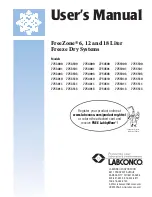
2
Product Service: Domestic 1-800-522-7658, International 816-333-8811
Chapter 1: Introduction
Freeze drying is a process whereby water is removed
from frozen materials by converting the frozen water
directly into its vapor without the intermediate
formation of liquid water. The basis for this
sublimation process involves the absorption of heat by
the frozen sample in order to vaporize the ice; the use
of a vacuum pump to enhance the removal of water
vapor from the surface of the sample; the transfer of
water vapor to a collector; and the removal of heat by
the collector in order to condense the water vapor. In
essence, the freeze dry process is a balance between the
heat absorbed by the sample to vaporize the ice and the
heat removed from the collector to convert the water
vapor into ice.
Freeze Dry Rates
The efficiency of the freeze drying process is dependent
upon the surface area and the thickness of the sample;
the collector temperature and vacuum obtained; the
eutectic point and solute concentration of the sample. It
is important to remember these three factors when
trying to obtain efficient utilization of your freeze dry
system. A listing of selected materials and their
approximate drying times are shown in Table 1 for your
reference.
SAFE TEMPERATURE AND DRYING TIMES
FOR SELECTED MATERIALS
Material
10mm Thick
Safe
Temperature
°C
Collector
Temperature
°C
Hours
(Approx.)
Milk -5
-40
10
Urea -7
-40
10
Blood Plasma
-10 to -25
-40
16
Serum -25
-40
18
Vaccinia
-30 to -40
-50
22
Influenza Vaccine -30
-50
24
Human Tissue
-30 to -40
-50
48
Vegetable Tissue
-50
-80
60
*Total sample quantities are contingent on various freeze dryer capacities.
Table 1









































